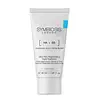What's inside
What's inside
 Key Ingredients
Key Ingredients

 Benefits
Benefits

 Concerns
Concerns

 Ingredients Side-by-side
Ingredients Side-by-side

Water
Skin ConditioningSqualane
EmollientGlycerin
HumectantCaprylic/Capric Triglyceride
MaskingIsoamyl Laurate
EmollientButyrospermum Parkii Butter
Skin ConditioningSorbitan Olivate
EmulsifyingCetearyl Olivate
Ceramide NP
Skin ConditioningJojoba Esters
EmollientSodium Hyaluronate
HumectantEuterpe Oleracea Sterols
Skin ConditioningLinoleic Acid
CleansingOleic Acid
EmollientLinolenic Acid
CleansingEthyl Linoleate
EmollientTocopherol
AntioxidantIsoamyl Cocoate
Cetyl Palmitate
EmollientSorbitan Palmitate
EmulsifyingCetearyl Alcohol
EmollientEthylhexylglycerin
Skin ConditioningCarbomer
Emulsion StabilisingSodium Hydroxide
BufferingPhenoxyethanol
PreservativeSodium Gluconate
Skin ConditioningWater, Squalane, Glycerin, Caprylic/Capric Triglyceride, Isoamyl Laurate, Butyrospermum Parkii Butter, Sorbitan Olivate, Cetearyl Olivate, Ceramide NP, Jojoba Esters, Sodium Hyaluronate, Euterpe Oleracea Sterols, Linoleic Acid, Oleic Acid, Linolenic Acid, Ethyl Linoleate, Tocopherol, Isoamyl Cocoate, Cetyl Palmitate, Sorbitan Palmitate, Cetearyl Alcohol, Ethylhexylglycerin, Carbomer, Sodium Hydroxide, Phenoxyethanol, Sodium Gluconate
Water
Skin ConditioningButyrospermum Parkii Butter
Skin ConditioningGlycerin
HumectantCetyl Alcohol
EmollientDicaprylyl Ether
EmollientPropylheptyl Caprylate
EmollientGlyceryl Stearate
EmollientDimethicone
EmollientPhenoxyethanol
PreservativePEG-75 Stearate
Cera Alba
EmollientNiacinamide
SmoothingPrunus Amygdalus Dulcis Oil
Skin ConditioningMaris Aqua
HumectantSodium Polyacrylate
AbsorbentCeteth-20
CleansingSteareth-20
CleansingParfum
MaskingTocopheryl Acetate
AntioxidantEthylhexylglycerin
Skin ConditioningAllantoin
Skin ConditioningPotassium Sorbate
PreservativeDisodium EDTA
Xanthan Gum
EmulsifyingLactic Acid
BufferingPropylene Glycol
HumectantSodium Hyaluronate
HumectantBakuchiol
AntimicrobialTocopherol
AntioxidantCI 15985
Cosmetic ColorantCI 17200
Cosmetic ColorantWater, Butyrospermum Parkii Butter, Glycerin, Cetyl Alcohol, Dicaprylyl Ether, Propylheptyl Caprylate, Glyceryl Stearate, Dimethicone, Phenoxyethanol, PEG-75 Stearate, Cera Alba, Niacinamide, Prunus Amygdalus Dulcis Oil, Maris Aqua, Sodium Polyacrylate, Ceteth-20, Steareth-20, Parfum, Tocopheryl Acetate, Ethylhexylglycerin, Allantoin, Potassium Sorbate, Disodium EDTA, Xanthan Gum, Lactic Acid, Propylene Glycol, Sodium Hyaluronate, Bakuchiol, Tocopherol, CI 15985, CI 17200
 Reviews
Reviews

Ingredients Explained
These ingredients are found in both products.
Ingredients higher up in an ingredient list are typically present in a larger amount.
This ingredient is also known as shea butter. It is an effective skin hydrator and emollient.
Emollients help soothe and soften your skin. It does this by creating a protective film on your skin. This barrier helps trap moisture and keeps your skin hydrated. Emollients may be effective at treating dry or itchy skin.
Shea butter is rich in antioxidants. Antioxidants help fight free-radicals, or molecules that may harm the body. It is also full of fatty acids including stearic acid and linoleic acid. These acids help replenish the skin and keep skin moisturized.
While Shea Butter has an SPF rating of about 3-4, it is not a sunscreen replacement.
Shea butter may not be fungal acne safe. We recommend speaking with a professional if you have any concerns.
Learn more about Butyrospermum Parkii ButterEthylhexylglycerin (we can't pronounce this either) is commonly used as a preservative and skin softener. It is derived from glyceryl.
You might see Ethylhexylglycerin often paired with other preservatives such as phenoxyethanol. Ethylhexylglycerin has been found to increase the effectiveness of these other preservatives.
Glycerin is already naturally found in your skin. It helps moisturize and protect your skin.
A study from 2016 found glycerin to be more effective as a humectant than AHAs and hyaluronic acid.
As a humectant, it helps the skin stay hydrated by pulling moisture to your skin. The low molecular weight of glycerin allows it to pull moisture into the deeper layers of your skin.
Hydrated skin improves your skin barrier; Your skin barrier helps protect against irritants and bacteria.
Glycerin has also been found to have antimicrobial and antiviral properties. Due to these properties, glycerin is often used in wound and burn treatments.
In cosmetics, glycerin is usually derived from plants such as soybean or palm. However, it can also be sourced from animals, such as tallow or animal fat.
This ingredient is organic, colorless, odorless, and non-toxic.
Glycerin is the name for this ingredient in American English. British English uses Glycerol/Glycerine.
Learn more about GlycerinPhenoxyethanol is a preservative that has germicide, antimicrobial, and aromatic properties. Studies show that phenoxyethanol can prevent microbial growth. By itself, it has a scent that is similar to that of a rose.
It's often used in formulations along with Caprylyl Glycol to preserve the shelf life of products.
Sodium Hyaluronate is hyaluronic acid's salt form. It is commonly derived from the sodium salt of hyaluronic acid.
Like hyaluronic acid, it is great at holding water and acts as a humectant. This makes it a great skin hydrating ingredient.
Sodium Hyaluronate is naturally occurring in our bodies and is mostly found in eye fluid and joints.
These are some other common types of Hyaluronic Acid:
Learn more about Sodium HyaluronateTocopherol (also known as Vitamin E) is a common antioxidant used to help protect the skin from free-radicals and strengthen the skin barrier. It's also fat soluble - this means our skin is great at absorbing it.
Vitamin E also helps keep your natural skin lipids healthy. Your lipid skin barrier naturally consists of lipids, ceramides, and fatty acids. Vitamin E offers extra protection for your skin’s lipid barrier, keeping your skin healthy and nourished.
Another benefit is a bit of UV protection. Vitamin E helps reduce the damage caused by UVB rays. (It should not replace your sunscreen). Combining it with Vitamin C can decrease sunburned cells and hyperpigmentation after UV exposure.
You might have noticed Vitamin E + C often paired together. This is because it is great at stabilizing Vitamin C. Using the two together helps increase the effectiveness of both ingredients.
There are often claims that Vitamin E can reduce/prevent scarring, but these claims haven't been confirmed by scientific research.
Learn more about TocopherolWater. It's the most common cosmetic ingredient of all. You'll usually see it at the top of ingredient lists, meaning that it makes up the largest part of the product.
So why is it so popular? Water most often acts as a solvent - this means that it helps dissolve other ingredients into the formulation.
You'll also recognize water as that liquid we all need to stay alive. If you see this, drink a glass of water. Stay hydrated!
Learn more about Water